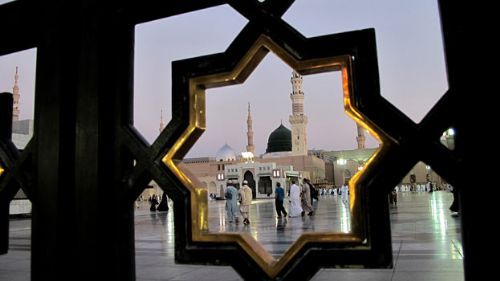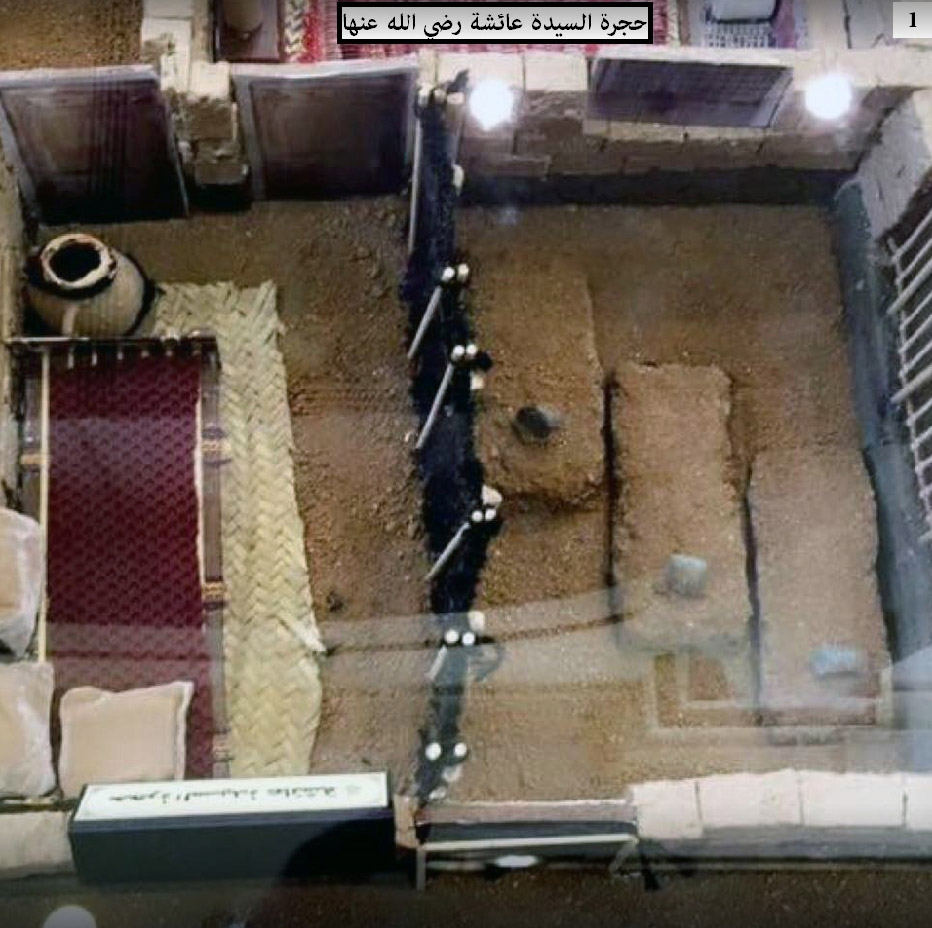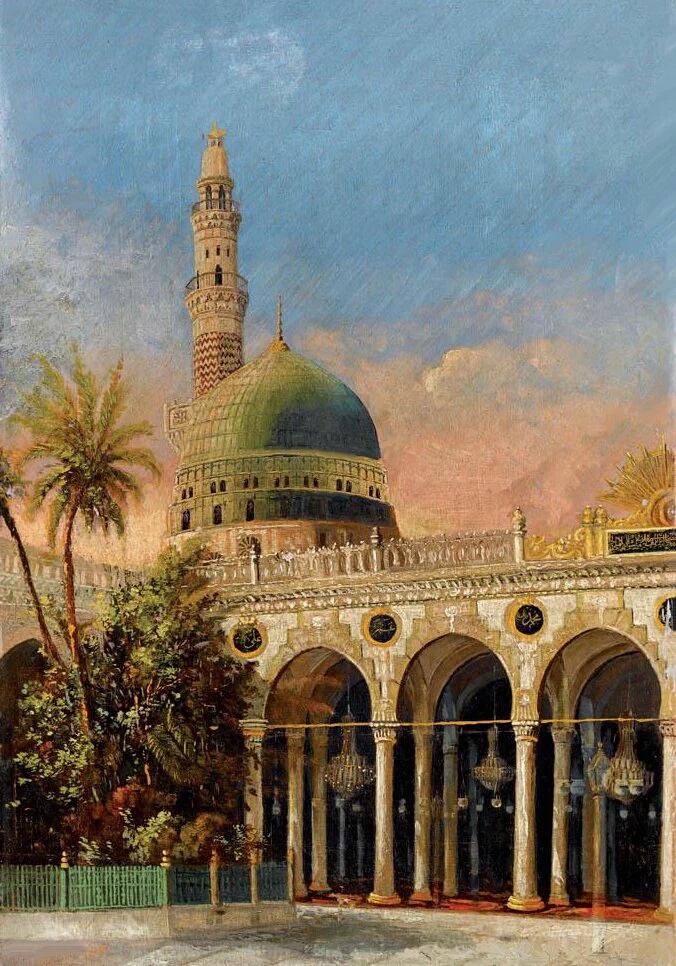.jpg)
WHO DOES THE SİNGLE GRAVE IN THE TOMB OF PROPHET MUHAMMED BELONG TO?
From time to time, some tomb pictures that are said to belong to the Prophet Muhammad (Peace be upon him) circulate in newspapers and social media. There are even those who enlarge it in the form of a poster and hang it on their houses' wall. These pictures have nothing to do with that holy grave.
The grave of Prophet Muhammad is inside a covered shrine surrounded by two intertwined walls. It has no door, and it is not possible to enter. Today, we do not have a picture of the tomb. According to the old sources, it is a grave with stones lined up and was piled up with earth. Although it was slightly curved when it is first made, it flattened over time.

Three friends together
The first shrine built in Islamic history is the shrine where the Prophet Muhammad is buried, also called Hujra al-Muattara (The Fragrant Room) or Hujra al-Saadah (The Blessed Room). The Prophet passed away in the room of his wife, Aisha, whom he loved very much. He was buried here because he said "Prophets are buried where they died".
Aisha had his father, the 1st Caliph Abu Bakr, buried here when he died. Before the second caliph Umar died, he asked Aisha for permission to be buried here. She gave permission by saying, "I prefer Umar to myself."
When Umar was buried, she drew a curtain behind the graves and lived in this room until her death in 678 (May Allah be pleased with them). When she died, she could not be buried here. Because there was a single burial place left in the room. This place is reserved for the Prophet Jesus, who will descend to the earth near the Qiyamah. Because the Prophet Muhammad said that when Jesus Christ died after coming down to earth, he would be buried next to himself. This saying was mentioned occurs in as-Sunan al-Tirmidhi and Sunan al-Darimi.
Mud-brick room with wooden ceiling, Aisha's room, 3 meters high, made of adobe; the ceiling was covered with palm branches. It had two gates, one on the west and the other on the north. The western gate opened to the side of Rawda al-Mutahhara (Clean Garden), the masjid of the Prophet Muhammad.
When Caliph Umar was expanding the Masjid an-Nabawi in the 638, he built a short stone wall around Hujra al-Saadah.
Caliph Abd Allah bin al-Zubayr, who died in 692, demolished this wall around his aunt Aisha's room and rebuilt it with black stone. This wall’s ceiling was open and it had a door on the north side.
When Hasan bin Ali, the grandson of the Prophet, died in 669, his brother Husayn, in accordance with his will, brought the funeral [as it is done today in Eyüp Sultan tomb in Istanbul] to the Hujra al-Saadah's gate to pray with the blessing of the Prophet.
At that time, there were those who thought that they would bury the body here and did not want him to be brought in. To avoid any commotion noise, it was not brought inside. After the prayer, he was buried in the famous cemetery of Medina, Jannat al-Baqi. In order to prevent such incidents in the future, this door of the wall and the room was walled up and closed.

No door left
When the Umayyad Caliph Walid was the governor of Medina, he raised the wall outside the tomb; covered with a small dome. The three tombs can no longer be seen from the outside and cannot be entered into the room.
While Umar bin Abd al-Aziz was the governor of Medina, in 706, while expanding the Masjid an-Nabawi by the order of Caliph Walid, a second wall was built around the tomb. This wall was pentagonal.
Jamal al-Din al-Isfahani, Salahaddin al-Ayyubi's cousin and Zangi's vizier, had a railings (shabaka) made of sandalwood and ebony trees around the outer wall of Hujra al-Saadah in 1188. The fence was high up to the ceiling of the mosque. A white silk curtain (sattara) on which the chapter of Surah al-Yasin was written in red silk, which was sent from Egypt that year, was hung around the railing.
But the railing later burned in a fire. In 1289, the railing was made of iron and painted green. This fence is called Shabaka al-Saadah. The qibla side is called Muwacaha al-Saadah, the eastern side is called Kadam al-Saadah, the western side is called Rawda al-Mutahhara, and the northern side is Hujra al-Fatima.
Today, in the middle of the Masjid an-Nabawi, that is, in the Rawda al-Mutahhara, the part of the mosque in the time of the Prophet, there is the Hujra al-Saadah on the left side of the person facing the qibla, and the pulpit on which the Prophet delivers his sermon on his right shoulder. Visiting the tomb of the Prophet can be done from outside the railing.

The Crusaders are at work
In 847, marble was laid between the location of the Shabaka al-Saadah and its outer walls and outside this place. The marbles were changed from time to time. Finally, it was renovated by the Ottoman Sultan Abdulmecid.
The Crusaders dug tunnels to smuggle the Prophet's corpse in the 1162. The Prophet appeared in the dream of Sultan Nour al-Din Zangi in Damascus. He informed of this conspiracy and showed the perpetrators.
The Sultan immediately came to Medina. He ordered all the people of the city to pass before him one by one. He identified and arrested the Crusaders who dug a tunnel in the guise of a darvish. He had a trench dug around the grave and had lead poured. The famous Ottoman traveler Evliya Çelebi explained this.
A similar attempt was made by Portuguese Admiral Alfonso d'Albuquerque in 1513. He began to invade the Red Sea. However, this project fell through after the Ottoman conquest of Egypt in 1517.
Green Dome
While the pentagonal walls of Hujra al-Saadah were being built, a small dome was built on them. This dome is called Qubba al-Nour. Above this is another larger green dome: Qubba al-Hadra. It was built from lead by the Mamluk Sultan of Egypt, Saleh Kalaun, in 1279.
Ottoman sultans always sent very ornate covers (Kiswa al-Sharifa) to cover this dome. The second big dome on the tomb was in the color of lead until 1837. It was painted green by Ottoman sultan Mahmoud II.
The fence surrounding the tomb of the Prophet has a door on the east, west and north sides. No one could enter through these doors except the black eunuchs (Aghas of Haram al-Sharif), who were the servants of the Prophet's Mosque. Aghas would sweep and wash the cell at certain times. The dust that came out was put in small bottles and distributed to the believers for blessings.
No one can enter inside the walls of the tomb. Because they don't have doors and windows. However, there is a small hole in the middle of the dome and it is closed with a wire mesh. A hole was also dug in the Qubba al-Hadra at the level of this hole.
70 oil lamps were lit in the shabaka. In addition to these, two large gold lamps were lit at the level of the Prophet's head, and two small gold lamps were lit at the level of the heads of his other two friends. The last building of Masjid an-Nabawi was built by the Mamluk Sultan Ashraf Kaitbay in 1483. It was repaired and decorated by the Ottoman Sultans. The current building of the masjid belongs to the Ottoman Sultan Abdulmecid and dates back to 1861.
.jpg)
Önceki Yazılar
-
THE OTTOMAN DYNASTY AND QURAYSH9.07.2025
-
"WOE TO THE ENEMIES OF THE REVOLUTION!" What Was The People’s Reaction To The Kemalist Revolutions?2.07.2025
-
DEATH IS CERTAIN, INHERITANCE IS LAWFUL!25.06.2025
-
THE SECRET OF THE OTTOMAN COAT OF ARMS18.06.2025
-
OMAR KHAYYAM: A POET OF WINE OR THE PRIDE OF SCIENCE?11.06.2025
-
CRYPTO JEWS IN TURKEY4.06.2025
-
A FALSE MESSIAH IN ANATOLIA28.05.2025
-
WAS SHAH ISMAIL A TURK?21.05.2025
-
THE COMMON PASSWORD OF MUSLIMS14.05.2025
-
WERE THE OTTOMANS ILLITERATE?7.05.2025